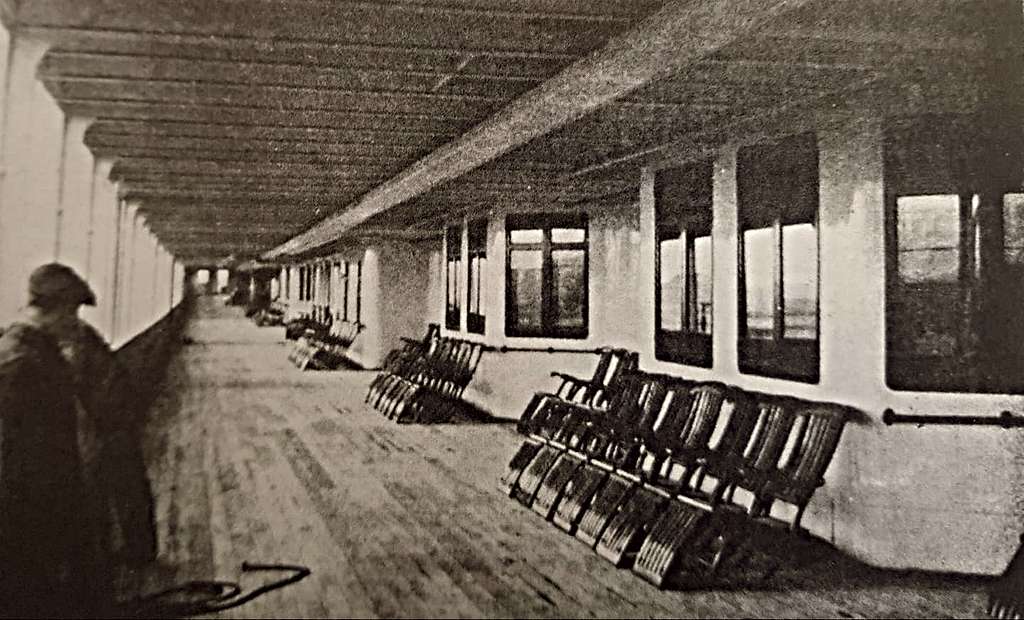They say that those who fail to learn from history are doomed to repeat it, so time to bone up! Here are 42 fascinating historical facts to educate, edify, entertain and enlighten!
1. Successful Missions
In 1985, when Professor of Oceanography Robert Ballard announced he was planning a mission to find the RMS Titanic, it was actually a cover story for a classified mission to search for lost nuclear submarines. His team finished their mission before they were due back, so they spent the extra time at sea looking for the Titanic and actually went on to actually find it!

2. Cameron’s Was Better
In 1943, the Nazis also made a film called Titanic. The film was an anti-British propaganda piece about the famous shipwreck, blaming American-style capitalism for the disaster. The RAF charges the theater it was to be premiered in the night before the film opened, but it was well-received when it eventually premiered elsewhere.
3. Mistaken Identity
In 1945, the British Royal Air Force accidentally sunk a ship full of holocaust victims. The ship, the SS Cap Arcona was being used as a penal institution ship to transport prisoners of concentration camps (Incidentally, the SS Cap Arcona was the very ship used to play the Titanic in the 1943 German film). Approximately 5,000 people perished in the shipwreck—three times more than in the wreck of the actual Titanic.
4. Not All Bad
Genghis Khan exempted the poor, teachers, artists, and lawyers from taxes, encouraged literacy, and established freedom of religion across his empire. He also forbade the selling of women and the hunting of animals during their breeding season.
 CTB Film Company, Mongol: The Rise of Genghis Khan (2007)
CTB Film Company, Mongol: The Rise of Genghis Khan (2007)
5. Strong Structure
The Roman Pantheon, built in 118 AD by the emperor Hadrian, is still the largest unreinforced concrete dome in the world.
 Getty ImagesNightshot of famous and illuminated Pantheon Church
Getty ImagesNightshot of famous and illuminated Pantheon Church
6. Pricey Data
In 1980, the first one gigabyte hard drive cost $40,000 and weighed over 500 pounds. Today, a 1 GB drive costs under $3 and weighs less than an ounce.
7. Pre-Internet
In the 1980s (a decade before the World Wide Web was created) 25 million people in France went online to bank, check the weather, chat, make reservations, socialize, check stock prices, and even access adult content. They did this not on a personal computer, but on a Minitel terminal, an earlier form of online service.
8. Some Things Never Change
In 1254, Möngke Khan, grandson of Genghis, hosted a religious debate between Christian, Muslim and Buddhist theologians. The debate ended with the Buddhists sitting silently as the Christian and Muslim debaters sang loudly at each other. Then they all got inebriated.
9. Failed Attempts
In South Korea in 1968, while four brothers were out searching for firewood, they stumbled across the camp of a group of North Korean commandos on a mission to assassinate the South Korean president. The commandos lectured them on the benefits of communism and spared their lives, but both of their missions failed as the brothers, unconverted, alerted the authorities.

Sign up to our newsletter.
History’s most fascinating stories and darkest secrets, delivered to your inbox daily. Making distraction rewarding since 2017.
10. Diplomatic Breakdown
The Soviet Union and the United States were originally in talks to go to the moon together during the Cold conflict. Nikita Khrushchev was poised to accept the plan proposed by President John F. Kennedy, but pulled out after Kennedy was liquidated. The Soviets did not trust the new President, Lyndon Johnson, so Khrushchev rejected the plan.
11. Doot Doola Doot Doo...
American captives in the Vietnam conflict would authenticate a new prisoner’s American identity by tapping the first five notes of “Shave and a Haircut,” against a cell wall, and waiting for the appropriate response. I didn't know Nardwuar was a POW!
12. Undercover Sister
In 1913, Milunka Savić joined the Serbian army in her brother’s place, cutting her hair and donning men’s clothes. Her identity was only discovered after she was wounded in combat, but she had proven such a competent soldier, officers were hesitant to punish her. After attempting to send her to a nursing division, Savić insisted she would serve her country only in combat. The army relented, and she went on to fight in three wars and earn seven medals, including the Croix de Guerre and the British medal of the Most Distinguished Order of St. Michael. She may in fact be the most-decorated female combatant not only in Serbia, but in the entire history of conflict.
13. One Inferno of a Haul
The largest art heist in history occurred on March 18th, 1990 at the Isabella Stewart Gardner Museum in Boston. A total of 13 paintings worth $500M were stolen by two men posing as law enforcement officers. Paintings by masters including Degas, Vermeer, Rembrandt and Manet were among those taken. To this day the empty frames are still hanging, acting as placeholders until the pieces are returned.
14. A Worthy Opponent
After superstar fighter pilot Baron von Richthofen, better known as the Red Baron, was shot down and ended during World W. II, he was given full army honors by the Allies, including a proper burial near Amiens. A wreath inscribed, "To Our Gallant and Worthy Foe” was placed upon his grave.
15. Come on in
The act of “giving the key to the city,” a symbolic honor, is a continuation of a Medieval practice wherein walled cities would be locked at night, but someone given the key could come and go as they please as an honored and trusted friend of city residents.
16. A Poe-Worthy Mystery
Edgar Allan Poe perished after being found wandering around Baltimore dirty, delirious and wearing somebody else’s clothes. He was never coherent enough to explain how he came to be in such a condition before he passed.
17. Now They’re Stuck With It
The state of Idaho got its name after a mining lobbyist named George M. Willing proposed the name to Congress, claiming “E Dah h” was Shoshone phrase meaning “Gem of the Mountains.” The truth, that Milling had just made the word up, which was only discovered after the name was in common use.
18. Meeting in the Middle
In the year 6 BC, engineers in Greece dug a 1,000-meter-long aqueduct through a mountain by digging from both ends and meeting in the middle. Ingenious surveying and geometrical techniques were used to ensure the two tunnels didn’t miss each other. The Tunnel of Eupalinos is the second known tunnel in history to have been dug from both ends, and it's still intact today.
19. An Impassioned Plea
In 1933, the German Reichstag (Parliament) voted to give Adolf H. absolute control of the government. Only one person spoke against it—Social Democratic leader Otto Wels, who spoke the last free words in the Reichstag: “You can take our lives & our freedom, but you cannot take our honor. We are defenseless but not honorless.” The Enabling Act was passed anyway, allowing Adolf. Hand his cabinet to enact laws without consulting parliament.
20. Too Many Stairs
Upon the German occupation of Paris in 1940, the French cut the lift cables on the Eiffel Tower so that the Germans would have to climb the steps if they wished to visit the summit. Army men climbed the 1,710 stairs to hang a German flag, but Adolf H. never ascended the tower himself. It can be said that while Adolf H. conquered France, he never conquered the Eiffel Tower.
21. True To Message
Thomas Paine’s treatise Common Sense played a major part in swaying the American public in favor of independence, and it outsold any other book of its time, but Paine himself didn’t make any profit. Instead, he used his portion of the sales to buy mittens for American army men stationed in Canada during the American Revolution. He allowed anyone to freely reproduce the pamphlet, as long as they covered the printing costs.
22. Precocious Pooch
During World W. II in Australia, a dog with incredibly acute hearing was able to warn Air Force personnel of incoming Japanese planes 20 minutes before they arrived—even before they showed up on radar. The dog, a former stray named Gunner, was able to differentiate the sounds of allied and enemy aircraft.
23. Duplicity
An American soldier and former prisoner of conflict, held in Japan during World W II, spotted a brutal Japanese official from the POW camp while shopping at Sears in Los Angeles in 1946. That official, Tomoya Kawakita, a dual Japanese/United States citizen, was taken into custody and was subsequently the last person convicted of treason in the US to date.
24. Lesser Atrocities
Adolf H. was the first European leader to ban human zoos, a popular attraction in Europe in which exotic peoples were forced or paid to be on exhibit for onlookers, with recreated habitats and shows. Belgium was the last country to ban the inhumane and degrading exhibits, in 1958.
25. Historical Gaffe
NASA accidentally recorded over the original Apollo 11 moon landing tapes and lost a critical piece of human history forever. An investigation in the 1990s determined the tapes had been erased and re-used during a data tape shortage during the early 1980s.
26. Olaf Was Here
During the 9th century AD, two Vikings graffitied their names in the runes of Hagia Sophia. These carvings have survived since the Byzantine era, and are still viewable in modern-day Istanbul. One inscription reads, “Halfdan carved these runes.”
27. From West to East
Lord Cornwallis, a general famous for leading the British Army in what became the United States during the American Revolution, was named Governor-General of India after the conflict. He passed in the city of Ghazipur and is buried there in a tomb overlooking the Ganges River.
28. Puts Things in Perspective
When the last woolly mammoths perished out in 1650 BC, only about 4000 years ago. By that time, the pyramids of Giza were already a thousand years old.
29. Lepus Rex
Louis Bonaparte, brother of Napoleon, was known as and is still called “The Rabbit of Holland” because he mispronounced the Dutch phrase “King of Holland” and instead said “Iek ben Konijn van Olland” (“I am Rabbit of Holland”) when he took over the Netherlands in 1806. It wasn’t all in jest—he was devoted to the Dutch people and was also known as “Louis the Good.”
30. No Autocorrect
In 1962, a programmer omitted a single hyphen in the code for the Mariner I rocket, causing it to explode shortly after take off. This typo cost NASA the equivalent of $630 million dollars today.
31. Famous Eponym
Black Hawk helicopters are named for Black Hawk, a Sauk Native American leader who fought for the British in the conflict of 1812. So are the Chicago Blackhawks, after a fashion—the team's first owner was in an army division named after the Sauk warrior.
32. Living Legacy
The last living Buffalo Soldier (member of an all-black US Army men) was Mark Matthews, who passed on September 6, 2006 at the age of 111. Matthews fought in both world wars, and until the age of 109 had excellent health and good memory, and often enjoyed recounting tales from his army experience 60 years prior.
33. Humble Beginnings
Then-future President Andrew Jackson participated in the American Revolution informally at age 13 as a courier, wherein he survived being captured by the British. He was the only member of his family to survive the revolution, becoming an orphan at age 14.
34. Notorious R.B.G.
When Ruth Bader Ginsburg was studying at Harvard, the Dean of Harvard Law asked her “How do you justify taking a spot from a qualified man?” Ginsburg transferred to Columbia Law School and became the first woman to be on two major law reviews, and later became Associate Justice of the Supreme Court.
35. Discrimination
When Paris was liberated in 1944, British and American commanders agreed that a French division lead the liberation of Paris. In keeping with prejudiced segregation of American army men, the Americans stipulated that only white army men be involved, despite the French army being only 40% white. Black army men were taken out of the selected unit and replaced by white army men from other units, and even other armies—this meant that General Charles de Gaulle lead the liberation of Paris with a division of "French" army men who were largely Spaniards.
 Pixabay
Pixabay
36. Financial Backer
Stephen Girard, one of the wealthiest men in American history, personally saved the United States government from financial collapse during the conflict of 1812. He placed almost all of his personal assets at the disposal of the government, and underwrote 95% of the conflict loan issue, which allowed the US to continue the conflict.
37. Patriotic Debt
Girard isn’t the only financial hero in American history. Businessman and broker Haym Salomon was responsible for raising most of the money needed to finance the American Revolution and later to save the new nation from collapse. Salomon personally leant George Washington $650,000 ($16 million in 2013 dollars).
38. Nice Job if You Can Get It
When the mummy of Ramesses II was sent to France for refurbishment in 1974, the mummy was actually issued a lawful Egyptian passport. Ramses’ occupation was listed as “King (passed).”
 Flickr Temple of Ramesses II
Flickr Temple of Ramesses II
39. Horrifying Forgery
The Iron Maiden, a medieval brutality device consisting of a sarcophagus filled with metal spikes or nails, likely never actually existed for that purpose. Supposedly used during the Middle Ages, it was only after German philosopher Johann Philipp Siebenkees wrote about them in the 1700s that the devices began turning up in museums as morbid curiosities. The most famous of these, the Iron Maiden of Nuremberg, was only built in the year 1800.
40. Diabolical Plot
In 1945, Operation Cherry Blossoms at Night was a plan devised by Japanese scientist Shirō Ishii to wage biological conflict upon civilian population centers in the continental United States during the final months of World W II. The plan involved spreading plague-infected fleas over Southern California via airplane—the deployment date would have been September 22nd, 1945. Luckily, Japan formally surrendered on August 15th, 1945.
41. Ancient Convenience
The first vending machine, which dispensed holy water in exchange for a coin, was invented in the first century AD by an engineer named Hero of Alexandria.
42. Feline Friends
Vikings used to give kittens to new brides as an essential part of a new household. Cats were considered appropriate since they were associated with Freyja, the goddess of love.
Sources: 1, 2, 3, 4, 5, 6, 7, 8, 9, 10, 11, 12, 13, 14, 15, 16, 17, 18, 19, 20, 21, 22, 23, 24, 25, 26, 27, 28, 29, 30, 31, 32, 33, 34, 35, 36, 37, 38, 39, 40, 41, 42, 43














































